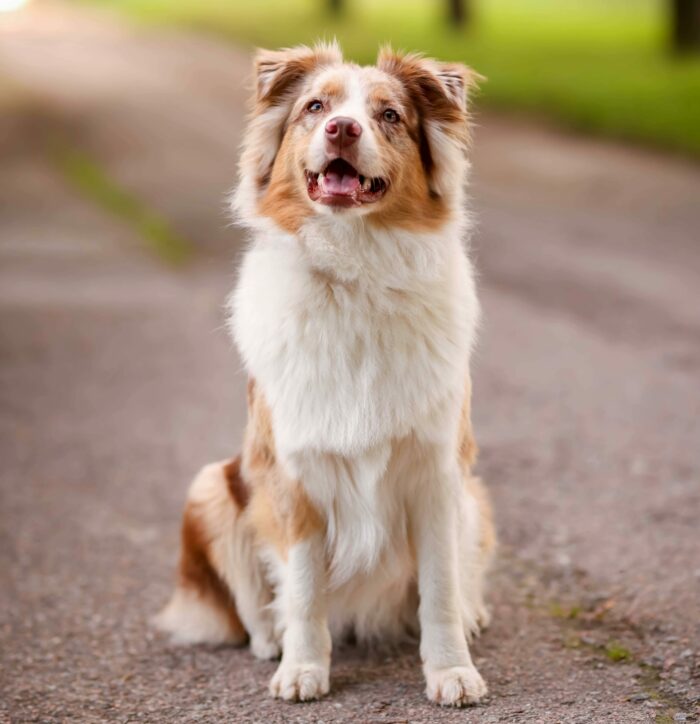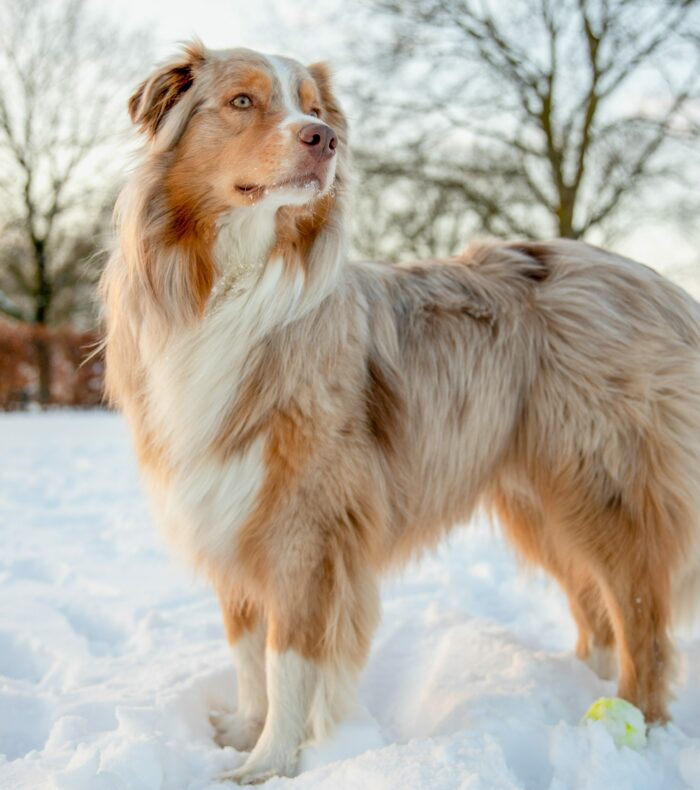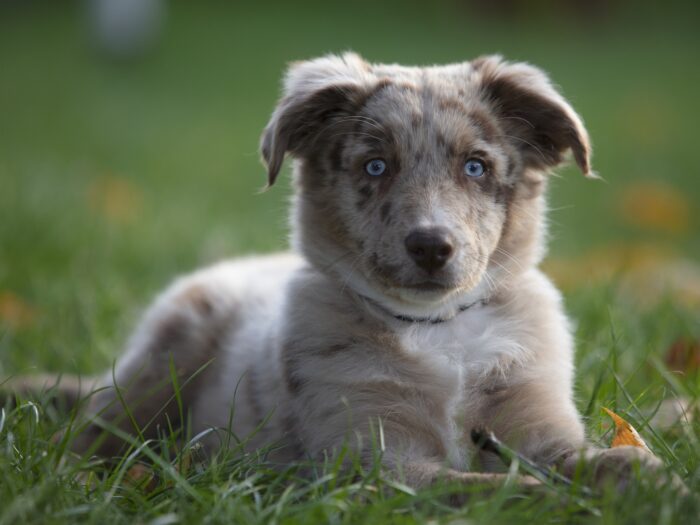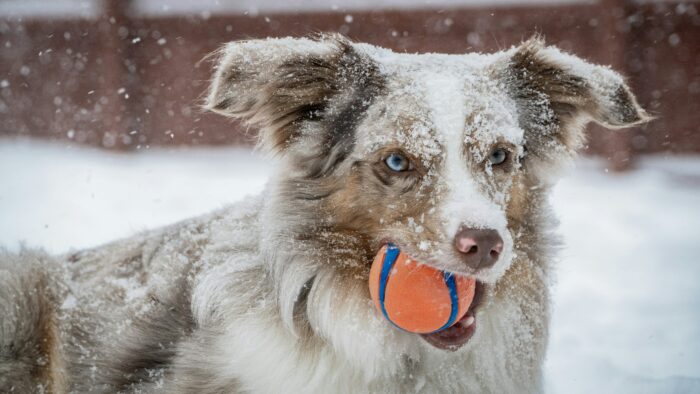Have you ever thought about what makes the Australian Shepherd so popular & flexible as a dog breed? Could it be their eye-catching looks, smart brains, or maybe their never-ending loyalty? Affectionately called the Aussie, this breed is more than just a pretty face. Embraced by the American Kennel Club in 1991, the Aussie’s popularity has soared – earning it the 12th spot out of 201 registered breeds in the AKC’s rankings. And this recognition really shows their adaptability and varied skills. In 2022, The Kennel Club registered 328 Australian Shepherds, proving they’re becoming more popular.
But what really sets them apart?
Keep reading to explore the depth of their character and what it takes to own an Aussie.
The information provided herein is for informational purposes only. Please refer to our disclaimer for more details..
- Quick Facts
- Breed Overview
- Australian Shepherd Dog History
- Australian Shepherd Appearance
- Australian Shepherd Size, Weight & Lifespan
- Australian Shepherd Personality & Temperament
- Australian Shepherd With Other Pets & Children
- Australian Shepherd Care & Grooming Requirement
- Australian Shepherd Health Issues
- Australian Shepherd Diet and Nutrition
- Australian Shepherd Training Requirements
- Australian Shepherd Exercise Needs
- Ideal Owner
- How To Get an Australian Shepherd?
- Conclusion
Quick Facts
Image credits: Valeria Boltneva
- Appearance: They’re medium-sized with a slightly wavy double coat. And you can find them in colors like black, blue merle, and red merle.
- Size: Males: 20-23 inches, 50-65 pounds | Females: 18-21 inches, 40-55 pounds.
- Temperament: Loyal, highly intelligent, trainable, strong family attachment but reserved with strangers.
- Compatibility: They’re great with kids & other pets if trained well. But, because they have a herding nature – you need to watch them.
- Grooming: They need regular brushing, sometimes a bath & care for their eyes, ears, and nails.
- Health Issues: They might get hip/elbow dysplasia, PRA, hereditary cataracts, iris coloboma, epilepsy, MDR1 mutation, deafness, various cancers, eye problems, Collie nose, and OCD.
- Diet and Nutrition: A high-protein diet is best for them, especially if they’re active. Supplements for joint and eye health are a good idea.
- Training Needs: They learn quickly, especially with early training and positive reinforcement.
- Exercise Requirements: They need 1-2 hours of active exercise daily, like running, playing fetch, and dog sports.
- Ideal Owner: Best suited for active, experienced dog owners – not ideal for apartment living.
- Acquisition: You can get them from breeders or rescue organizations.
- Price: Buying from a breeder costs $1,000 to $3,000, but adopting costs $150 to $400.
- Lifespan: 12-15 years.
- Breed Group: Herding
Breed Overview
The Australian Shepherd, or Aussie, is a lively, smart medium-sized dog. It’s famous for its slightly wavy, mid-length double coat. This breed started in the United States, where ranchers used their great herding skills. These dogs have a history that ties back to European breeds that went to Australia.
Aussies aren’t just good at herding. They’re also stars in agility, obedience & dog sports like flyball. Their boundless energy and intelligence require an active lifestyle – making them unsuitable for sedentary homes. Just a short walk isn’t enough for them.
Aussies love doing tasks, like herding, helping as guides or therapy dogs, or simple jobs at home. They are loyal and protective, forming strong bonds with their families. Their striking appearance, featuring eyes that may be brown, blue, green, yellow, or amber, adds to their allure.
Australian Shepherd Dog History
Image credits: Maud Slaats
The Australian Shepherd, despite its name, actually comes from America. It has a history that’s deeply connected to Western U.S. culture. First used for herding, these dogs’ ancestors were European herding breeds from the Pyrenees Mountains. In the 1800s, Basque shepherds ventured from Europe to Australia, and then to California –bringing along their trusted herding dogs. And in Australia, these dogs were mixed with Border Collies & other breeds, creating today’s Aussie.
Ranchers in the U.S. thought these dogs were from Australia, so they called them Australian Shepherds. This working breed was perfected in the U.S., gaining prominence as a ranch and rodeo dog. Their agility and intelligence made them stand out in rodeos and Western horse riding events after World War II. And the American public loved them.
The American Kennel Club recognized the Australian Shepherd in 1991. Later, in 2015, they also recognized the Miniature American Shepherd, a smaller version of the Aussie.
Australian Shepherd Appearance
The Australian Shepherd, a medium-sized dog, is really strong and agile. It stands out because of these features:
- Body and Build: The Australian Shepherd is a medium-sized dog with a solid and muscular build. And, this breed is characterized by a slightly longer body than height, giving them an athletic and robust appearance – perfect for their original role in herding.
- Coat: Their coat is medium length, has two layers, is water-resistant & is good for all kinds of weather. And, the fur’s length varies on the body, with a thicker undercoat for extra protection.
- Color Variations: Aussies come in many colors, like black, blue merle, red merle, red, and sometimes with tan points. Their patterns can be solid or mixed with white, black, tan, and gray.
- Ears and Eyes: They have ears that flop forward and eyes that are oval and come in brown, amber, or blue.
- Tail: In the past, Australian Shepherds had their tails docked, but selective breeding has led to many being born with naturally bobbed tails (short). This change is more humane.
Australian Shepherd Size, Weight & Lifespan
Image credits: Atahan Demir
Australian Shepherds are known for being smart and good at herding.
Males usually are 20 to 23 inches tall and weigh 50 to 65 pounds. Females are a bit smaller, at 18 to 21 inches tall and weighing 40 to 55 pounds.
And there’s also a smaller type – the Miniature American Shepherd. These mini Aussies are up to 18 inches tall & weigh 20 to 40 pounds. With these size options, dog owners can find a good match.
The average lifespan of an Australian shepherd is between 12-15 years while that of a miniature American shepherd is 12-13 years.
Australian Shepherd Personality & Temperament
The Australian Shepherd is a dog breed loved for its mix of traits and personality, making it a beloved companion for many families. Here are the key parts of its temperament:
- Loyalty and Intelligence: Aussies are known for being really loyal and smart. They often show a strong & confident personality. And this intelligence makes them easy to train.
- Social Behavior: They might be a bit shy with new people, but warm up after proper introductions. With other dogs, they’re usually balanced – not too distant but not overly friendly either.
- Attachment to Family: These dogs get very attached to their human families, often following them around like a shadow. And, this trait, however, can lead to separation anxiety, necessitating careful dog training to develop healthy attachment styles.
- Herding Instinct: Because they were bred for herding, they sometimes try to be the boss. It’s important to lead them confidently. They’re quick and like to chase, so keep them on a leash or in a safe area to prevent escapes and ensure their safety.
Australian Shepherd With Other Pets & Children
Australian Shepherds, with their herding heritage, often perceive children as part of their ‘flock’ – necessitating early training to curb any tendencies to chase or nip. Once taught, they become the best dogs for families with kids. Crucial safety tips include:
- Teach Children: Kids should learn how to be around dogs. They should be respectful, especially when the dog is eating or resting. And they shouldn’t take the dog’s food.
- Supervision: Always watch when Aussies & young kids are together to avoid any problems.
- Behavior with Other Pets: Usually, Aussies are fine with other pets. But sometimes their herding nature shows, especially with cats or smaller animals as they try to herd them. This needs to be watched and managed.
Early and proper socialization helps them get along with kids and other pets.
Australian Shepherd Care & Grooming Requirement
Image credits: Wolfgang157
Taking care of an Australian Shepherd’s coat and grooming is an essential aspect of their health and well-being. Here’s what you need to know about grooming them:
- Routine Brushing: Their medium-length double coat sheds all year, especially in spring. So brush them at least once or twice a week to avoid tangles and mats, especially:
- Behind the ears
- And around the tail.
- Bathing: Aussies have a weather-resistant coat – but they get dirty because they’re so active. Bathe them when needed, but not too much, to keep their skin from getting dry. And always use a shampoo made for dogs.
- Skin and Coat Health: Regular grooming sessions are opportunities to check for skin issues like sores, rashes, dryness, or even ring worms. A healthy coat should be shiny – not dull.
- Eye and Ear Care: Routine checks for eye discharge and keeping ears clean & dry are crucial, especially after bathing, to prevent infections.
- Nail Trimming: Cut their nails regularly to stop them from getting uncomfortable or breaking. You’ll know their nails are too long if they click on the floor.
- Avoid Shaving: Don’t shave their double coat. It helps them keep the right body temperature.
Australian Shepherd Health Issues
The Australian Shepherd, a generally healthy and robust breed, is nonetheless predisposed to certain health issues, which owners should be aware of:
- Elbow and Hip Dysplasia: These are inherited issues where the hip or elbow joints don’t form right, causing misalignment, pain & arthritis. Treatments include medicines, joint supplements, and different therapies. And surgery might be needed for serious cases.
- Progressive Retinal Atrophy (PRA): PRA affects the photoreceptors in the retina – leading to deteriorating vision and eventual blindness. Early signs are night blindness and clumsiness. There’s no cure, so dogs with PRA need to adjust to losing their sight.
- Hereditary Cataracts: Common in Aussies from 1-5 years old, this makes the eye’s lens cloudy, impairing vision and possibly causing blindness or glaucoma. Surgery is usually the treatment.
- Iris Coloboma: An inherited eye problem caused by the iris not forming properly, leading to light sensitivity or discomfort. So it’s advisable to protect severely affected dogs from bright sunlight, possibly with dog goggles.
- Epilepsy: A seizure disorder that’s common in Aussies. This disorder is managed with medication. And dogs with epilepsy can live a full life with the right care.
- Multidrug Resistance Mutation (MDR1): A genetic mutation, that makes Aussies more sensitive to certain drugs – causing adverse reactions at doses tolerated by other dogs. Testing for this mutation helps in giving them the right medical care.
- Deafness: Often linked to their coat color genes, especially in double-merle Aussies. The BAER test can check for deafness. Caring for a deaf dog needs special training aids.
- Lymphosarcoma and Hemangiosarcoma: These are cancers more common in this breed. Lymphosarcoma, which affects white blood cells, can be treated with chemotherapy. Hemangiosarcoma, more serious, may need surgery and chemotherapy.
- Eye Problems: These include progressive rod-cone degeneration (PRCD) and canine multifocal retinopathy (CMR), leading to issues like retinal detachment.
- Nasal Solar Dermatitis (Collie Nose): This happens to dogs with little nose pigment. You can manage it with sun protection measures like:
- Dog sunscreen
- Or tattooing the nose.
- Osteochondrosis Dissecans (OCD): A painful joint issue due to cartilage growing wrong. It might need surgery.
Australian Shepherd Diet and Nutrition
Australian Shepherds have specific dietary needs based on their activity levels and life stages.
- Puppies up to 12–16 months old should eat standard puppy food, divided into three or four meals a day.
- Active adult Aussies, especially those with tough jobs or lots of exercise – might need a diet high in protein and fat. And this kind of diet is often called “performance” or “sport.” Ask a vet for advice. Adults usually eat two balanced meals each day, with the amount depending on their size, age, and how active they are.
As they age, joint supplements and possibly eye health supplements might be recommended by your vet, considering their predisposition to osteoarthritis & eye conditions.
Australian Shepherd Training Requirements
Image credits: Kameron Kincade
Australian Shepherds are smart & good at learning new things. Early socialization and basic obedience training, including commands like ‘sit’ and ‘stay’, are crucial – especially since Aussies can be reserved around strangers. And these dogs love having a job to do, so they do well in:
- Dog sports
- Therapy work
- Herding on farm
- Search and rescue work
Training with rewards like praise, play, or treats works best. It’s also important to train them not to nip or chase, which are part of their natural herding behavior.
Australian Shepherd Exercise Needs
Australian Shepherds are very energetic, so they need a lot of exercise. At least two hours of active exercise every day is necessary. Good activities for them include:
- Running
- Walking
- Playing fetch or frisbee
- And doing dog sports like agility, flyball, or herding tests.
They also need mental exercise – like puzzle toys and scent games. For Australian shepherd puppies, moderate exercise is key to avoiding stress on their developing skeletal system.
Ideal Owner
The Australian Shepherd is best for experienced dog owners who thrive on active, engaging lifestyles. They need owners who can give them a lot of training & exercise – due to their high energy and intelligence. They’re great for people who like dog sports and teaching their dogs tricks. And their energetic nature makes them less suited for apartment living.
How To Get an Australian Shepherd?
For those interested in acquiring an Australian Shepherd – there are two primary routes: purchasing from a breeder or adopting.
- Prospective buyers can visit the AKC Marketplace, a trusted source for puppies from registered breeders. And it’s crucial to check health certifications from organizations like the Canine Eye Registry Foundation & the Orthopedic Foundation of America. A puppy from a good breeder usually costs $1,000 to $2,000, but the really high-quality ones can be over $3,000. Online sites like PuppySpot are also good for finding Australian Shepherds.
- Alternatively, you can adopt one from rescue organizations or animal shelters. This can be cheaper, with prices from $150 to $400. And you can find Aussies that need homes at local shelters or through breed-specific groups like:
Conclusion
The Australian Shepherd is a remarkable breed, combining intelligence, loyalty, and adaptability in a beautiful, medium-sized package. These dogs need to be active and do best where they can move around and think. They are amazing pets for people who like to stay active. Remember, responsible ownership involves understanding their grooming needs, health issues & exercise requirements.
If you’re thinking about getting an Aussie – you’re not just getting a pet. You’re getting a lively and loving family member. Embrace the journey with your Australian Shepherd, and you’ll discover an enriching, joyful partnership.
370views
Share on Facebook
 Dark Mode
Dark Mode 

 No fees, cancel anytime
No fees, cancel anytime 


























































-1
0